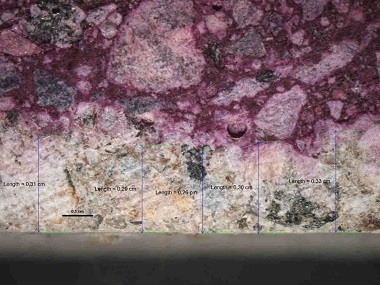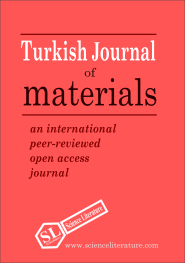
Effect of mineral additive use on permeation properties of concrete and the relationship between permeation and carbonation
Abstract
Full Text:
PDFReferences
A.D. Aydin, R. Gül, Influence of volcanic originated natural materials as additives on the setting time and some mechanical properties of concrete, Construction and Building Materials 21 (2007) 1277–1281.
S.A. Barbhuiya, J.K. Gbagbo, M.I. Russell, A.M. Basheer, Properties of fly ash concrete modified with hydrated lime and silica fume, Construction and Building Materials 23 (2009) 3233–3239.
T. Nochaiya, W. Wongkeo, A. Chaipanich, Utilization of fly ash with silica fume and properties of Portland cement–fly ash–silica fume concrete, Fuel 89 (2010) 768–774.
O. Kayali, B. Zhu, Corrosion performance of medium-strength and silica fume high-strength reinforced concrete in a chloride solution, Cement & Concrete Composites 27 (2005) 117–124.
M. Mazloom, A.A. Ramezanianpour, J.J. Brooks, Effect of silica fume on mechanical properties of high-strength concrete, Cement & Concrete Composites 26 (2004) 347–357.
X. Pu, Investigation on pozzolanic effect of mineral additives in cement and concrete by specific strength index., Cement and Concrete Research, 29(1999) 951–955.
M. Şahmaran, H.A. Christianto, Ö. Yaman, The effect of chemical admixtures and mineral additives on the properties of self-compacting mortars, Cement & Concrete Composites 28 (2006) 432–440.
H. Yazıcı, The effect of silica fume and high-volume Class C fly ash on mechanical properties, chloride penetration and freeze–thaw resistance of self-compacting concrete, Construction and Building Materials 22 (2008) 456–462.
X.Y. Wang, H.S. Lee, Modeling the hydration of concrete incorporating fly ash or slag, Cement and Concrete Research 40 (2010) 984–996.
I.L. Müller, Influence of silica fume addition on concretes physical properties and on corrosion behaviour of reinforcement bars., Cement & Concrete Composites 26 (2004) 31–39.
H.W. Song, S.W. Pack, J.C. Nam, V. Saraswathy, Estimation of the permeability of silica fume cement concrete, Construction and Building Materials 24 (2010) 315–321.
J. Skalny, J. Marchand, I. Odler, Sulfate Attack on Concrete, Spon Press, New York (2002).
H.W. Song, J.C. Jang, V. Saraswathy, K.J. Byun, An estimation of the diffusivity of silica fume concrete, Building and Environment 42 (2007) 1358–1367.
M.S. Ahmed, O. Kayali, W. Anderson, Chloride penetration in binary and ternary blended cement concretes as measured by two different rapid methods, Cement & Concrete Composites 30 (2008) 576–582.
C. Taşdemir, Combined Effect of Mineral Admixtures and Curing Conditions on the Sorptivity Coefficienty of Concrete, Cement and Concrete Research, 33 (2003) 1637-1642.
D.P. Bentz, Influence of silica fume on diffusivity in cement-based materials II. Multi-scale modeling of concrete diffusivity. Cement and Concrete Research 30 (2000) 1121–1129.
W. Zhu, J.M. Bartos, Permeation properties of self-compacting concrete, Cement and Concrete Research, 33 (2003) 921-926.
K.Y. Ann, S.W. Pack, P.P. Hwang, H.W. Song, S.H. Kim, Service life prediction of a concrete bridge structure subjected to carbonation, Construction and Building Materials 24 (2010) 1494–1501.
B. Johannesson, P. Utgenannt, Microstructural changes caused by carbonation of cement mortar, Cement and Concrete Research 31 (2001) 925–931.
X.Wang, H.A. Lee, model for predicting the carbonation depth of concrete containing low-calcium, fly ash, Construction and Building Materials, 23 (2009) 725-733.
C.H. Chang, J.W. Chen, The experimental investigation of concrete carbonation depth, Cement and Concrete Research 36 (2006) 1760– 1767.
H.W. Song, S.J. Kwon, K.J. Byun, C.K. Park, Predicting carbonation in early-aged cracked concrete, Cement and Concrete Research 36 (2006) 979–989.
W.A. Klemm, R.L. Berger, Accelerated curing of cementitious systems by carbon dioxide: part I. Portland cement. Cement and Concrete Research; 2(5) (1972) 567–576.
M.P. Kulakowski, F.M. Pereira, D.C.C. Dalmolin, Carbonation-induced reinforcement corrosion in silica fume concrete, Construction and Building Materials;23(3) (2009) 1189–1195.
E.K.K. Nambiar, K. Ramamurthy, Sorption characteristics of foam concrete, Cement and Concrete Research 37 (2007) 1341– 1347.
U.N. Kockal, F. Türker, Effect of environmental conditions on properties of concretes with different cement types, Construction and Building Materials, 23 (2009) 1862-1870.
TS EN 12390-3, Testing hardened concrete, Compressive strength of test specimens, Standard, (2010).
TS EN 12390-6, Testing hardened concrete, Tensile splitting strength of test specimens, Standard, (2010).
TS EN 12504-2, Testing concrete in structures, part-2 non-destructive testing, determination rebound number, Standard, (2004).
Copyright (c) 2018 Turkish Journal of Materials

This work is licensed under a Creative Commons Attribution-NonCommercial 4.0 International License.
Indexing:









